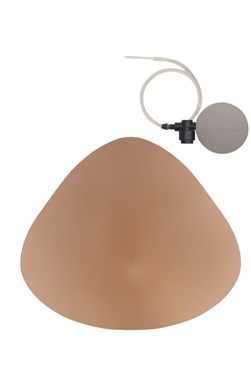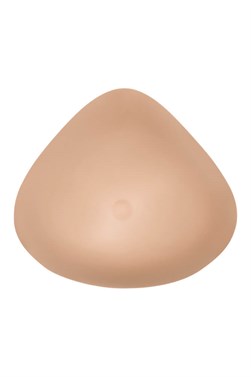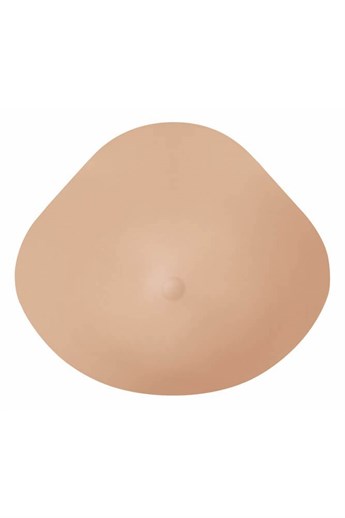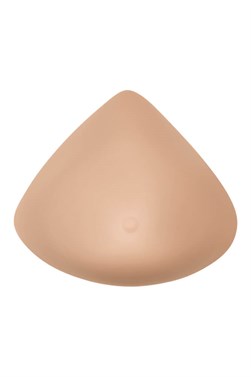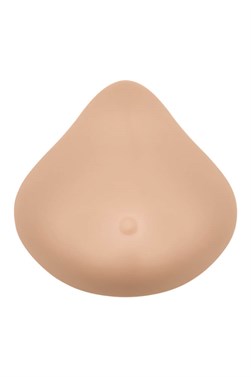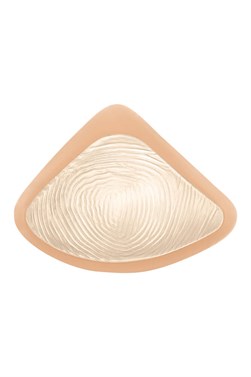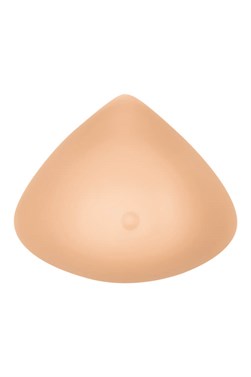Tip top - do nipples matter?
Do nipples matter?
Supplied to women by Mother Nature to help them nourish their young (and weirdly, provided to men too), nipples might be something we take for granted, but a breast can look lonely without one. We asked readers whether nipples really are the ‘cherry on the cake’!
When you lose a breast, you will almost certainly choose to wear a breast form or have reconstruction. Both will give you an outline that belies the fact that you’ve had surgery. But what you will also have lost is your nipple. And, while it can be embarrassing when you enter a cold room wearing a close-fitting top and some clever clogs quips that it’s rude to point, most women prefer to restore a nipple outline after surgery.There are several routes you can take to achieve this, from bespoke silicone nipples to medical tattooing and from skin transplants to Amoena’s own self-adhesive nipples.
Make me a new one
The trend in breast cancer treatment these days is definitely towards either breast-conserving surgery (lumpectomy) with immediate reconstruction, or, if a full mastectomy is needed, again to provide immediate reconstruction. More and more women, therefore, are waking up from surgery with a reconstructed breast, which many believe helps them cope with the emotional impact of breast cancer: they feel more ‘womanly’ with two breasts and can focus on getting their lives back to normal, whereas a mastectomy without reconstruction would be a constant reminder that they have had cancer. Other women have a reconstructive procedure some time after their mastectomy. But why go on to restore a nipple? Body image is a sensitive issue and sometimes our insistence on ‘perfection’ can be somewhat irrational (and almost incomprehensible to our long suffering partners). For example, a woman will go through a lot to recreate the breast or breasts she has lost to cancer, even though the world will probably never see them. And when some women have gone through hours of reconstructive surgery, sometimes having flesh removed from other parts of their body and ending up with not just one scar site but several, they often feel that the breast mounds they are left with are somehow naked without the nipple. Cliché it may be, but many use the phrase ‘It’s the cherry on the cake’, and are not satisfied until it is back in pride of place.
I feel like a woman
Nipples come in all shapes and sizes. Some women do not have prominent nipples anyway, so they don’t feel it necessary to either have one reconstructed or wear a prosthetic nipple to avoid looking lop-sided on a cold day. Others are not so much bothered about the effect when clothed, but simply want to look as good as they can ‘for themselves’. For them, it’s about going from an almost androgynous chest appearance to having two womanly breasts again.
So what are the options? The first is nipple reconstruction, where your surgeon will create a new nipple shape, either by cutting into the reconstructed breast and leaving it to scar over and form a raised area that mimics an areola, which will then be tattooed, or by grafting some skin from an area like your inner thigh, which is slightly darker in appearance anyway, onto your reconstructed breast. This might also be tattooed in due course to colour-match with your other nipple.
Sarah Henson had immediate reconstruction following her radical mastectomy. Having been told by her local hospital in Peterborough that it would not be possible, she asked for a second opinion and discovered that she could have the procedure at Addenbrookes Hospital in Cambridge. “For me, mentally it would have been far more traumatic if I had been left with no breast at all – this wasn’t vanity, it was about how well I felt I was dealing with the disease”, she said.
In a ten-hour TRAM-flap operation (or transverse rectusabdominis myocutaneous flap) procedure, Sarah’s breast tissue was removed and muscle and skin was taken from her abdomen to create a new breast shape. “They took veins from my legs for the blood supply. They then have to crack your ribs to set up the supply and do the mastectomy through the nipple. I opted for this procedure because I didn’t want anything artificial [i.e. a silicone implant].”
Before her procedure, Sarah’s surgeon had talked to her about creating a new nipple once her new breast had healed and settled down. She wanted to know her options but found it difficult to discover any details. “I was desperately seeking information on the internet – something like this article actually! I wanted to know what it was going to look like and what was going to happen. You can’t picture it in your head. I asked at the hospital if I could see any pictures but they just said ‘It will be fine’. There is very little information available, which is why I like to tell other women about it if they want to know,” explained Sarah.
When she decided to go back for a new nipple, a lot of her friends and family asked why. “They were surprised I was going back for more – I’d been through so much, but it is about feeling whole and coming to terms with what you have had done.
Psychologically it has boosted me. You feel really self-conscious sometimes, and when I didn’t have a nipple I felt odd. People would stare – for example in changing rooms. It was a bit like when I lost my hair.” She did consider prosthetic nipples but, she confessed: “To me, anything ‘extra’ is just a nuisance.
It’s a bit like my wig, which I never wore! I am an all or nothing person. I rang the hospital and they said I could just have a tattoo for the colour of a nipple, or I could have a new nipple constructed. I decided to go for the latter.”
Sarah’s procedure involved a skin graft from her inner thigh. “They stitched it onto my reconstructed breast, then twisted it and clamped it to make a nipple shape. At first it was far too large and I was worried that it would stay that way, but it did settle down and it has gradually shrunk in size so it’s a great match for my existing nipple now.
“I remember joking with my surgeon that surely with all the amazing medical advances over the past few years, they could grow a new nipple on – for example – a mouse, and then simply transfer it to me. He said ‘Yes, Sarah, we could do that but you’d have to have the mouse attached too!’ We did have a giggle over that.”
Lack of wildlife aside, after the operation Sarah could not have been more pleased: “I am so grateful for all the professionalism I received. It has helped me get better and I just can’t thank people enough – all the surgeons and nurses, all the staff at the hospital.”
Delighted with the result, she said: “It’s like putting a dot at the end of the line. I am over this; I have got through breast cancer. That’s how it has made me feel.”
Sarah’s advice to other women is to find out as much as possible about their options beforehand. “It was quite alarming to discover how little information is out there. Just keep on digging, don’t take no for an answer. And never be afraid to ask for a second opinion.”
Getting it right
Linda Player had a more complicated journey towards a reconstructed breast and nipple that she could be happy with. Diagnosed in 1991, she was treated with tamoxifen and did not undergo a lumpectomy until 2003, which was followed by reconstruction with a silicone implant the next year.
However, she was subsequently diagnosed with Paget’s Disease (cancer of the nipple) and had to have a complete mastectomy. Linda opted for a DIEP flap reconstruction (deep inferior epigastric artery perforator flap – an evolution of the TRAM fl ap, which again uses flesh and blood supply from the abdomen), which was not carried out at the same time as her mastectomy. However, her reconstructed breast was about an inch and a half lower than her other breast, which caused her severe back problems: “I had to lean to one side in order to make my bra fit properly, which of course led to horrendous postural problems”, she said.
An operation to correct this was only partially successful. Determined to achieve a better result, Linda carried out extensive research on the internet and found a plastic surgeon in her area (East Grinstead) called Mr Davison, who was prepared to try and even up her reconstructed breast. “He did a great job, after which I had to have six months’ physiotherapy to sort out my neck and shoulder problem.”
About two years later, Linda decided she would like to have a nipple created, so she asked Mr Davison, who said he would do this by tweaking and pulling the skin out, then creating a line around the outside in the shape of an areola. This would then be tattooed to arrive at a natural colour. Unfortunately the new areola was somewhat larger than her other nipple but when she went to see medical tattoo specialist Helen Porter (see opposite) about her tattooing, Helen advised that she could reduce the size of the areola scarring and then tattoo a nipple shape to match Linda’s remaining breast.”
Helen also helped minimise the other surgery scars that I had,” said Linda. “They have all flattened and a lot of the discolouration has gone. She has done a great job with my nipple, too. I am delighted.”
Linda is also adamant that women need to know their options before agreeing to reconstructive procedures of any kind. “Do a lot of research before you go ahead,” she advised, “and remember you need a plastic surgeon for the reconstructive work. Ask to see examples of what they have done before, so you know what to expect.”
Designs on you
Pat Bussy had a mastectomy with immediate LAT flap and expander reconstruction five years ago this November. She found the whole process rather overwhelming and, because decisions had to be taken so quickly, quite confusing: “My surgeon went into the details of the mastectomy so thoroughly and I was in such a state of shock that I had breast cancer, I just wanted the cancer gone. He showed me lots of photos of reconstruction and I thought ‘I don’t even know if I can make a decision about this’. I remember he said ‘You should have a reconstruction, you are still young,’ although I don’t think we discussed nipples at that stage.” Pat was extremely pleased with her reconstruction, although after about six months, when her surgeon asked whether she would like a new nipple, she told him she did not want any more surgery. “I had already had to have my implant replaced, which meant a second procedure, and I said ‘No, enough is enough.’ I have two friends who have had breast cancer and one of them had a nipple made. It is permanently erect and very lumpy – that wasn’t a look I wanted. He then asked whether I had thought about stick-on nipples. I didn’t even know they existed.”Pat’s surgeon referred her to Wexham Park Hospital in Slough, to a man called John Buckle. Mr Buckle is the consultant maxillofacial prosthetist at Wexham Park. During Pat’s consultation with him, “He explained everything very nicely and said ‘We can either make a nipple from scratch or make a mould from your existing nipple.’ We decided to use my existing nipple as the template, so he went ahead and took the mould and then about two weeks later my new nipples were ready. He makes five at a time – which I thought quite bizarre. I asked him why and he said: ‘Well you never know, you might lose one in M&S!’ Now, whenever I am in a changing room I always have a final look round before I leave to check that I haven’t left my nipple behind! He told me they would last for eight or nine years if I wear them all the time.”
Pat sticks her nipple on with special glue and it will usually stay on for about three months. She is pleased that she decided to visit Mr Buckle: “I didn’t think I wanted another nipple but you feel very whole again when you wear them. It’s completely painless, too, which is another bonus after so much surgery. He does a lot on the NHS but we paid for mine – about £450 – it was my birthday present that year!”
After wondering whether she could be bothered with a new nipple, Pat admits that she does feel more relaxed now in situations like swimming pool changing rooms or if she’s ever lucky enough to visit a spa. “I was always very self-conscious, but now it makes you feel like everybody else and you don’t get looked at.”
Sticking around
Like Pat, Barbara Heard decided she did not want further surgery following her mastectomy with immediate reconstruction in 2005. When she subsequently had to have her implant changed, her surgeon suggested that she could have a new nipple created but she felt that a skin graft was an operation too far and, instead, she carried on using self-adhesive nipples.
Amoena’s range of self-adhesive nipples has recently been relaunched, with softer silicone for the most natural look and feel, a slightly firmer areola that is visible through the material of most bras, and a bigger range of colours and sizes. Incorporating the clever, non-sticky, self-adhesive technology used in Amoena’s Contract breast forms, they adhere directly to the skin, and are intended to be removed at the end of each day. Because Barbara was already using Amoena’s nipples, we asked her to try the new range and report back on her experiences for this article. Barbara had always been very pleased with Amoena’s nipples but, she explained: “Because they are so fine at the edges, where they taper down to your own skin, I have to be extremely careful when I remove them because they can tear quite easily. I found this with the new nipples too, although the silicone is definitely tougher.” Adhesion remains excellent, however, said Barbara, admitting that when she started using the nipples several years ago, she often forgot to remove them at night: “They do stay on well. When I got my first set I didn’t realise they were meant to be removed at the end of the day and put on again in the morning. They tend to fall off when you have a shower though!” Did she find the new nipples easy to care for?“They are very easy to use – no trouble at all. As with the previous ones, they come with a cleanser that prepares both your skin and the adhesive surface. As long as you keep everything clean, there’s never any worry that it won’t stick.”
Will she carry on using the new Amoena nipples? “Yes, I would like to continue with them because I am fairly big boobed and if it is cold, it’s obvious that I only have one nipple. I would normally put a nipple on when I get dressed in the morning and then I’d forget about it for the rest of the day. I must say the shape is great – you do feel confident when you wear them. I’m not sorry that I didn’t go ahead with nipple reconstruction – personally I think stick-on nipples are much more convenient. I have not seen a reconstructed one but I have heard that the result isn’t always good. I remember going into a changing room with my friend and when she saw my reconstructed breast and I told her I was wearing a self-adhesive nipple, her eyes nearly popped out of her head. She didn’t know it wasn’t real!”
Amoena’s sales director, Loretta Pitt, has heard similar comments from many women. “Lots of our customers tell us they don’t want to put themselves through yet more surgery, but they really love the look they get from our self-adhesive nipples,” she said. “They are so versatile – they can be adhered to a breast form for a very realistic outline, as well as to a reconstructed breast. But they have other uses, too. Sometimes radiotherapy can change the appearance of a natural nipple, and because they are slightly recessed at the back they can be stuck over your own nipple to help achieve a balanced look by ensuring both breasts are identical.”
What’s your dream topping?
So although we might take them for granted while we still have two, nipples can become a bit of a holy grail when breast cancer deprives us of one – or both. However you decide to replace yours, we hope this article has helped you to consider your options. Thankfully, there are so many possibilities these days that it’s much more likely you’ll arrive at a solution that suits you. Private or NHS? Many hospitals now offer nipple tattooing but some women prefer to seek out an independent medical tattooist.Helen Porter tattooed Linda Player’s nipple at her salon, Evolution Skin Studios, in Canterbury. A qualified medical tattoo practitioner, Helen also trains and lectures practitioners, surgeons and nurses in medical tattooing.“Before we could colour her new nipple, we worked on Linda’s scarring,” she explained. “To minimise the new areola, we used a very fine needle to tattoo through the scar tissue. This causes a micro trauma to the skin, which forces the body to repair itself by producing new collagen fibres – it is great for repairing scar tissue. Traumatised skin over-produces collagen, which can result in scarring and unevenness – this often happens after major surgery. We break it down and it is carried away through the lymph system.”
Sadly, scar removal is not generally available as part of breast cancer care. “Sometimes a woman’s scarring can be worse, psychologically, than the fact that she doesn’t have a nipple, yet it is very difficult for women to find out that this service is available to them. Because it is not life threatening, it is seen as ‘just one of those things,’ and not as something that has to be addressed as part of a woman’s treatment.”
The nipple tattooing process will vary according to surgery and skin type – sometimes Helen tattoos a 3D effect nipple onto a reconstructed breast where no new nipple has been created and sometimes she colours a reconstructed nipple. “We draw on the shape and size before putting needle to skin. I like to create a build-up of colour in two or three sessions to get it just right; it is a layering process.” Sessions are roughly four weeks apart. Top-ups will be needed every few years, according to how much sunlight exposure the breast is subject to.
Despite the rise in reconstructive breast surgery, Helen has not seen her business increase because, she says, more hospitals are training their nurses in medical tattooing. “You do have to be careful, though,” she cautioned. “Whoever you choose to do the work – and you can Google medically trained tattoo artists if your hospital doesn’t offer this service – make sure you see their portfolio of before and after shots. Pictures will show you more than a thousand words.” Helen feels that the procedure is definitely worth having: “It makes the biggest difference to a reconstructed breast. It goes from looking quite strange and almost childlike to looking normal again. And when a nipple is created, it takes the eye away from any scarring.”
Helen can be contacted on 01227 764633, by email on info@evolutionskinstudios.com, or go to www.evolutionskinstudios.com.
In-house expert
Annette Tracey is a clinical nurse specialist who has worked at George Eliot Hospital in Nuneaton for the past 26 years. One of only about 40 original breast care nurses in the UK, she feels privileged to have seen the evolution in breast care that has taken place in the course of her career. It was one of the plastic surgeons at the hospital who suggested she should think about offering nipple tattooing to her patients. Annette was keen to help, but getting started was quite a challenge. “There were no courses at that time, so I went to the local tattooist and explained what I wanted to do. They let me sit in and watch people having their tattoos done.
“It became quite an obsession with me – even when I went on holiday I nipped into the tattoo shop to have a quick look at how they did it,” she said. “Eventually I found a breast care nurse on the other side of Birmingham who had started doing nipple tattooing a couple of years before. I tracked her down and she gave me a lot of information and guidance. It is basically like learning to write again. If you give a small child a pencil they snap it because they press too hard. Tattooing is similar. You need to learn the correct pressure so that the needle goes into the skin at the right level and the ink ‘takes’.” Annette started practicing on, of all things, a banana skin, eventually moving on to tattooing pig skins which the local butcher gave her. Understandably nervous about her first real nipple tattoo, Annette remembers that she couldn’t sleep the night before her planned follow-up call to see if her patient was happy with the result. “I thought, what if she said she didn’t like it? I had been through her whole breast cancer journey with her, and seen the process of her getting back to normality. What if I got it wrong and ruined everything? When she answered the phone and I said ‘Hi, it’s Annette,’ she started taking really deep breaths and I honestly didn’t know what she was going to say. When she finally could talk, she said ‘I can’t thank you enough – you have transformed everything for me.’ She cried, and so did I!”
That was back in July 2002. Since then, Annette has tattooed 267 patients and has taught the same skills to several other nurses, although most hospitals now send their tattooists on official training courses. An acknowledged specialist, she takes referrals from patients across the midlands, including Warwick and parts of Birmingham. Recently she took delivery of a new tattooing machine from Finishing Touches, a company that supplies and trains many of the medical tattooists in the UK and around the world. “We were so grateful for this donation,” said Annette. “The money for the machine was raised by local people, some of whom have benefited from the treatments we offer here. The new machine is lightweight, modern and so easy to use.”





